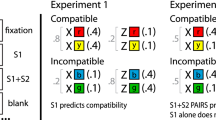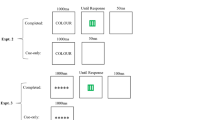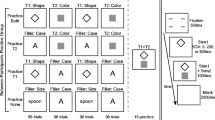Abstract
The present study investigates the effect of practice in a psychological refractory period (PRP) paradigm on the backward compatibility effect (BCE), in order to determine the locus of this response priming effect on Task1 performance. In two experiments, we show that the size of the BCE is closely associated with the duration of the response selection stage in Task1. When this stage is shortened through PRP practice, the magnitude of the BCE decreases. Subsequently increasing the duration of Task1 response selection results in a larger BCE, but manipulating the same stage in Task2 does not. Our results suggest that the BCE reflects crosstalk of unattended response information for Task2 acting on the response selection stage in Task1, and that response information for two tasks may be activated simultaneously.



Similar content being viewed by others
Notes
Credit and compensation rates implemented incentives and penalties as motivation, determined using each individual’s Task1 accuracy and RT from the previous session.
Correlational analysis of RT1 versus BCE using individual participants’ data over training sessions would be strongly driven by RT1 variability between participants, due to causes unrelated to RS shortening over practice. Our analyses here focus on interpretability of within-participant changes over practice.
References
Beherer, L., Kramer, A. F., Peterson, M. F., Colcombe, S., Erickson, K., & Becic, E. (2005). Training effects on dual-task performance: are there age-relate differences in plasticity of attentional control? Psychology and Aging, 20, 695–709.
Ellenbogen, R., & Meiran, N. (2008). Working memory involvement in dual task performance: Evidence from the backward compatibility effect. Memory & Cognition, 36, 968–978.
Hommel, B. (1998). Automatic stimulus–response translation in dualtask performance. Journal of Experimental Psychology: Human Perception & Performance, 24, 1368–1384.
Hommel, B., & Eglau, B. (2002). Control of stimulus-response translation in dual-task performance. Psychological Reseearch, 66, 260–273.
Karlin, L., & Kestenbaum, R. (1968). Effects of number of alternatives on the psychological refractory period. Quarterly Journal of Experimental Psychology, 20, 167–178.
Lien, M.-C., & Proctor, R. W. (2002). Stimulus-response compatibility and psychological refractory period effects: Implications for response selection. Psychonomic Bulletin & Review, 9, 212–238.
Miller, J., & Alderton, M. (2006). Backward response-level crosstalk in the psychological refractory period paradigm. Journal of Experimental Psychology: Human Perception and Performance, 32, 149–165.
Pashler, H. (1994). Dual-task interference in simple tasks: Data and theory. Psychological Bulletin, 116, 220–244.
Pashler, H., & Baylis, G. (1991). Procedural learning: 1. Locus of practice effects in speeded choice tasks. Journal of Experimental Psychology: Learning, Memory, and Cognition, 17, 20–32.
Ruthruff, E., Johnston, J. C., & Van Selst, M. (2001). Why practice reduces dual task interference. Journal of Experimental Psychology: Human Perception and Performance, 27, 3–21.
Ruthruff, E., Van Selst, M., Johnston, J. C., & Remington, R. (2006). How does practice reduce dual task interference: Integration automatization, or just stage-shortening? Psychological Research, 70, 125–142.
Schubert, T., Fischer, F., & Stelzel, C. (2008). Response activation in overlapping tasks and the response-selection bottleneck. Journal of Experimental Psychology: Human Perception & Performance, 34, 376–397.
Strobach, T., Liepelt, R., Pashler, H., Frensch, P. A., & Schubert, T. (2013). Effects of extensive dual-task practice on processing stages in simultaneous choice tasks. Attention, Perception, Psychophyiscs, 75, 900–920.
Thomson, S. J., & Watter, S. (2013). Information continuity across the response selection bottleneck: Early parallel response selection for unattended tasks influences later overt responses. Attention, Perception, & Psychophysics, 75, 934–953.
Thomson, S. J., Watter, S., & Finkelshtein, A. (2010). Parallel response selection in dual-task situations via automatic category-to-response translation. Attention, Perception, & Psychophysics, 72, 1791–1802.
Van Selst, M. A., Ruthruff, E., & Johnston, J. C. (1999). Can practice eliminate the psychological refractory period effect? Journal of Experimental Psychology: Human Perception and Performance, 25, 1268–1283.
Watter, S., & Logan, G. D. (2006). Parallel response selection in dual-task situations. Perception & Psychophysics, 68, 254–277.
Author note
We are grateful to members of McMaster University’s Cognitive Science Laboratory for assistance with data collection, and to Karin R. Humphreys for useful discussions about this work. This research was supported by a Natural Sciences and Engineering Research Council of Canada (NSERC) Grant #327454 to S.W., and by an NSERC postgraduate scholarship (PGS-D) to S.J.T. Correspondence concerning this article should be sent to S. J. Thomson or S. Watter, Department of Psychology, Neuroscience & Behaviour, McMaster University, 1280 Main Street West, Hamilton, L8S 4K1, Canada (email: thomsosj@mcmaster.ca or watter@mcmaster.ca).
Author information
Authors and Affiliations
Corresponding author
Rights and permissions
About this article
Cite this article
Thomson, S.J., Danis, L.K. & Watter, S. PRP training shows Task1 response selection is the locus of the backward response compatibility effect. Psychon Bull Rev 22, 212–218 (2015). https://doi.org/10.3758/s13423-014-0660-z
Published:
Issue Date:
DOI: https://doi.org/10.3758/s13423-014-0660-z




